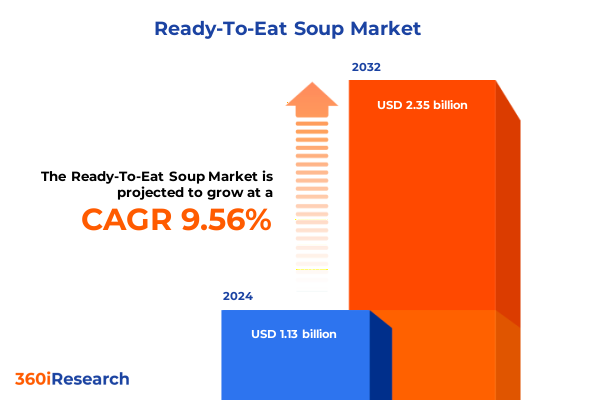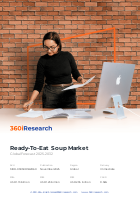The Ready-To-Eat Soup Market size was estimated at USD 1.13 billion in 2024 and expected to reach USD 1.23 billion in 2025, at a CAGR of 9.56% to reach USD 2.35 billion by 2032.

Exploring how shifting lifestyles and health trends are driving innovation and consumer adoption in the ready-to-eat soup category
In recent years, the ready-to-eat soup category has witnessed remarkable expansion as consumers increasingly prioritize convenience and wellness in their dietary choices. With hectic work schedules and on-the-go lifestyles, time-poor individuals are gravitating towards products that offer minimal preparation without sacrificing quality or taste. The ease of heating or consuming pre-packaged soups aligns with modern demands for instant gratification, driving manufacturers to expand their portfolios with innovative packaging formats and a broader array of global flavor profiles.
Moreover, heightened health consciousness among consumers has prompted brands to reformulate soups with clean-label ingredients and functional additives such as turmeric and probiotics. This shift is evident in the launch of new products featuring superfoods and natural preservatives that appeal to immune-support and digestive wellness seekers. As a result, ready-to-eat soups have evolved beyond simple meal replacements to become vehicles for nutritional enhancement and flavor exploration in the packaged food aisle.
Examining the major transformations reshaping product innovation, consumer preferences, and competitive dynamics in the ready-to-eat soup industry
As the ready-to-eat soup landscape evolves, manufacturers are embracing transformative shifts in product innovation, sustainability, and consumer engagement. Ethnic and premium flavor profiles have surged, with brands introducing Thai curry, Mexican chili, and Indian masala variants to satisfy adventurous palates. This diversification reflects a growing demand for authentic global tastes within convenient formats, elevating soups from mere pantry staples to culinary experiences.
Simultaneously, sustainability and packaging ingenuity are redefining market dynamics. Companies are investing in recyclable and biodegradable materials, transitioning from rigid metal cans to lightweight pouches and aseptic cartons to reduce environmental footprints. Such initiatives resonate with eco-conscious consumers and align with regulatory pressures to address plastic waste and carbon emissions. Additionally, digital and direct-to-consumer channels have gained prominence as brands leverage e-commerce platforms and social media campaigns to reach time-pressed audiences, further accelerating the ready-to-eat soups’ transformation.
Unpacking how U.S. trade policies and rising tariffs on steel and aluminum imports are influencing packaging costs and profit margins in soup manufacturing
U.S. trade policies have introduced significant headwinds to soup manufacturers by raising input costs for metal packaging. Since early 2025, tariffs on steel and aluminum imports have doubled to 50%, amplifying expenses for can-based products. Industry reports estimate that these levies could drive up can prices by as much as 24% by spring 2026, placing upward pressure on both consumer prices and profit margins in the soup sector.
However, domestic recycling infrastructure has provided a degree of insulation. Over 70% of the aluminum used in U.S. beverage cans originates from recycled sources, which mitigates some tariff impacts for manufacturers that secure recycled feedstock. Despite this, the remaining 30% of metal containers still exposed to import duties face notable cost escalation, compelling producers to explore alternative materials like cartons, pouches, and glass, or to optimize packaging portfolios to preserve affordability and competitiveness.
Key segmentation revelations highlighting how packaging, temperature handling, product origins, and distribution channels are shaping market opportunities
Analysis across different dimensions reveals strategic opportunities and challenges for industry participants. When evaluating packaging formats such as bags, bowls, cans, cups, and pouches, it becomes clear that while cans remain trusted for extended shelf life and consumer familiarity, flexible pouches and single-serve cups are capturing share among mobile and younger demographics seeking portability.
Temperature handling insights further illustrate market segmentation: ambient soups dominate traditional retail channels with stable sales, while chilled formats are carving out premium niches in grab-and-go and deli sections, and frozen soups appeal to health-focused shoppers prioritizing clean labels and minimal additives.
Product sourcing distinctions underscore growing demand for organic offerings alongside conventional lines. Although conventional soups continue to account for volume leadership, organic variants are outpacing growth as shoppers demand transparency and perceived health benefits.
In distribution channels, foodservice venues such as cafeterias, institutional operators, and restaurants support bulk consumption and custom recipes, whereas retail channels-from convenience stores and online platforms to specialty shops and supermarket hypermarkets-offer wide-ranging assortments. Each channel segment demands tailored product specifications, from portion sizes to packaging convenience and pricing structures.
This comprehensive research report categorizes the Ready-To-Eat Soup market into clearly defined segments, providing a detailed analysis of emerging trends and precise revenue forecasts to support strategic decision-making.
- Packaging Type
- Temperature
- Product Source
- Sales Channel
Critical regional dynamics in the Americas, Europe Middle East & Africa, and Asia Pacific that underscore diverse consumption patterns and growth catalysts
Regional dynamics spotlight distinct growth vectors and consumer behaviors. In the Americas, the United States leads the ready-to-eat soup segment with revenue of US$4.56 billion in 2025, reflecting a robust 6.75% annual growth rate driven by e-commerce expansion, health-oriented innovation, and home-cooking resurgence amid economic uncertainty. Meanwhile, Brazil reported US$1.85 billion in 2024 revenue, underpinned by urbanization and a blend of traditional flavors and convenience packaged to suit busy lifestyles.
Within Europe, the Middle East & Africa corridor emphasizes plant-based and vegan formulations alongside sustainable packaging. Consumers gravitate towards low-sodium, organic soups and eco-friendly containers in response to regulatory mandates and elevated environmental awareness, fostering growth in premium and private-label segments.
The Asia-Pacific region, encompassing markets such as China, Japan, and Southeast Asia, exhibits a mix of cultural preferences and convenience demands. Self-heating formats and online hyper-local delivery services thrive in China, while instant noodle-based soups remain a staple in Japan and South Korea. Across APAC, rising urbanization and health consciousness drive adoption of low-sodium, organic, and plant-based soups, reinforcing the region’s status as a key growth arena.
This comprehensive research report examines key regions that drive the evolution of the Ready-To-Eat Soup market, offering deep insights into regional trends, growth factors, and industry developments that are influencing market performance.
- Americas
- Europe, Middle East & Africa
- Asia-Pacific
In-depth overview of leading industry players driving innovation, strategic pivots, and competitive positioning in the ready-to-eat soup market
Major industry players exhibit varied strategies to maintain and expand their market presence. The Campbell Soup Company has leveraged its heritage brands to outperform expectations in Q3 2025, achieving a 7% increase in its meals and beverages segment amid heightened at-home dining trends and navigating tariff impacts through pricing and supply-chain adjustments.
Conagra Brands remains at the forefront of frozen convenience, introducing over 50 new single-serve and multi-serve meals, including gluten-free and plant-based options, in June 2025, thereby reinforcing its leadership in the category and responding to value-seeking consumer behavior.
General Mills has sharpened its consumer value proposition by increasing media investment and deploying data-driven marketing to target GLP-1 users with protein- and fiber-enriched Progresso offerings, while managing cost pressures and private-label competition through brand innovation and promotional tactics.
Niche specialists such as Amy’s Kitchen continue to fuel growth in the organic segment, unveiling five new global-inspired canned soups that marry authentic international flavors with clean-label credentials, appealing to health-conscious and allergen-aware consumers across mainstream and specialty channels.
This comprehensive research report delivers an in-depth overview of the principal market players in the Ready-To-Eat Soup market, evaluating their market share, strategic initiatives, and competitive positioning to illuminate the factors shaping the competitive landscape.
- Campbell Soup Company
- Unilever PLC
- General Mills, Inc.
- Nestlé S.A.
- Conagra Brands, Inc.
- The Kraft Heinz Company
- The Hain Celestial Group, Inc.
- McCormick & Company, Incorporated
- B&G Foods, Inc.
- Premier Foods plc
- Ottogi Co., Ltd.
Actionable strategic imperatives for beverage and food manufacturers aiming to capitalize on emerging consumer trends and operational efficiencies
To capitalize on evolving consumer preferences, industry leaders should prioritize sustainable packaging innovations that reduce environmental impact while preserving product integrity and shelf life. Transitioning to recyclable and compostable materials will resonate with eco-aware shoppers and help manage tariff-driven cost increases in metal-based containers by diversifying material usage.
Comprehensive explanation of research methodologies and analytical frameworks employed to ensure data integrity and balanced insights
This research employs a multi-stage methodology combining primary research, secondary data analysis, and rigorous validation processes. Initially, in-depth interviews with senior executives from key soup manufacturers, packaging suppliers, and retail buyers provided qualitative insights into market drivers and strategic priorities. Concurrently, consumer surveys quantified purchasing behaviors across demographic cohorts to identify emerging consumption patterns.
Secondary research encompassed the review of government agencies, customs data, industry journals, and financial filings to compile historical trends, tariff schedules, and cost structures. Data triangulation ensured consistency and reliability, while statistical analysis and scenario modeling examined the sensitivity of pricing and volume under varying tariff and economic conditions. The resulting framework offers a balanced blend of qualitative and quantitative insights, supporting robust strategic decision-making.
This section provides a structured overview of the report, outlining key chapters and topics covered for easy reference in our Ready-To-Eat Soup market comprehensive research report.
- Preface
- Research Methodology
- Executive Summary
- Market Overview
- Market Insights
- Cumulative Impact of United States Tariffs 2025
- Cumulative Impact of Artificial Intelligence 2025
- Ready-To-Eat Soup Market, by Packaging Type
- Ready-To-Eat Soup Market, by Temperature
- Ready-To-Eat Soup Market, by Product Source
- Ready-To-Eat Soup Market, by Sales Channel
- Ready-To-Eat Soup Market, by Region
- Ready-To-Eat Soup Market, by Group
- Ready-To-Eat Soup Market, by Country
- Competitive Landscape
- List of Figures [Total: 28]
- List of Tables [Total: 513 ]
Concise synthesis of critical findings culminating in strategic perspectives that encapsulate the ready-to-eat soup market's evolution
The ready-to-eat soup market has progressed from a convenience-driven niche to a dynamic category characterized by health-focused formulations, packaging evolution, and digital outreach. Consumer demand for clean-label, functionally fortified soups coexists with a sustained appetite for global flavors. Packaging formats have diversified to meet mobility and sustainability imperatives, while digital and omnichannel strategies amplify brand engagement.
Trade policies have introduced cost pressures that underscore the importance of supply-chain agility and materials innovation. Simultaneously, leading companies are navigating competitive headwinds by leveraging heritage assets, targeted marketing, and portfolio diversification. These intertwined trends delineate a sector in transformation, offering both challenges and opportunities for stakeholders committed to delivering value, quality, and environmental stewardship in the years ahead.
Next steps to engage with expert insights and secure actionable market intelligence by connecting with Ketan Rohom today
To access the full market research report and gain exclusive insights into consumer behavior, packaging innovation, and competitive strategies, please reach out to Ketan Rohom, Associate Director, Sales & Marketing, to purchase the comprehensive analysis.

- How big is the Ready-To-Eat Soup Market?
- What is the Ready-To-Eat Soup Market growth?
- When do I get the report?
- In what format does this report get delivered to me?
- How long has 360iResearch been around?
- What if I have a question about your reports?
- Can I share this report with my team?
- Can I use your research in my presentation?




